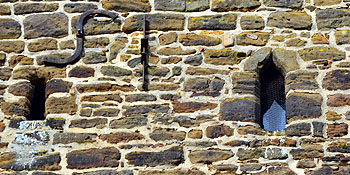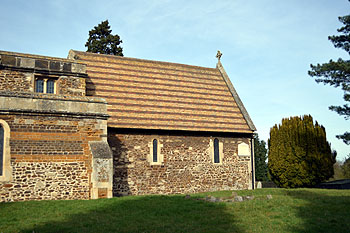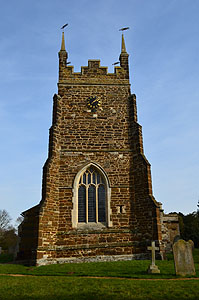Everton Church Alterations and Additions
![The church and Everton House prior to 1852 [Z50/45/7]](/CommunityHistories/Everton/Everton-Images/The-church-and-Everton-House-prior-to-1852-Z50-45-7350x181.jpg)
The church and Everton House prior to 1852 [Z50/45/7]
Most of the structural history of the church can be found in detail in Bedfordshire Historical Record Society Volume number 73 of 1994 Bedfordshire Churches in the Nineteenth Century: Part IV Appendices and Index, put together by former County Archivist Chris Pickford from numerous sources some held by Bedfordshire Archives and Records Service and some held elsewhere or published. Sadly Bedfordshire Archive and Record Service has no archive for the parish of Everton as it lies in the Archdeaconry of Huntingdon rather than Bedford, even though the church is now in Bedfordshire.

Tower windows February 2013
Four of the five church bells were cast between 1580 and 1630, the former bellframe also being erected at the latter date. In the early 1720s a new altar was installed “on a site raised upon three stone steps” and in 1729 a new pulpit and reading desk were given by William Astell of next-door Everton House, he also rebuilt the family pew. The pulpit was decorated with purple cushions.

The south door February 2013
In 1755 John Berridge became vicar. He was a noted evangelical preacher and writer, a friend of John Wesley, founder of Methodism. Berridge died in 1793 and is buried in the churchyard. He furnished the church as a preaching house in 1771, resembling more a later nonconformist chapel than an Anglican church. As may be imagined this did not go down well with the bishop or archdeacon! Almost as soon as Berridge was dead the archdeacon tried to enforce changes on the men of the parish vestry; they resisted.

Gargoyle at the west end of the south aisle February 2013
The roof was repaired in 1816 and in 1835 the pulpit and reading desk were finally moved back from the south side of an aisle back into the church. In 1837 new pews were introduced, the pulpit again moved to its accustomed place at the east end of the nave and the pews and galleries were removed from the chancel.

The church from the north-west February 2013
By 1852 some of the windows were blocked up. Everton House was being demolished that year and a clock was removed from the stables and given to the church. A restoration was carried out in 1864 under the auspices of John Harvey Astell of Woodbury Hall. Work was completed the next year and involved rebuilding the north aisle, inserting a new east window and providing new roofs for chancel and aisles. A new font was provided, new seating in the nave and aisles and choir stalls in the chancel. Heating apparatus was also installed.

The chancel from the south February 2013
The pulpit was replaced by a stone one in 1885. The bells were re-hung in 1892 and the tenor re-cast two years later. A new stained glass window was installed in 1904. The south aisle roof was repaired in 1911 and the clock was restored the following year. The east end of the chancel was panelled in oak in 1925 and in 1928 a reredos and rood screen introduced.
![The west tower about 1930 [X704/294]](/CommunityHistories/Everton/Everton-Images/The-west-tower-about-1930-X704-294203x299.jpg)
The west tower about 1930 [X704/294]
On 16th July 1974 lightning struck the tower and destroyed the stained glass in the east window. On advice of an architect the top stage of the tower was removed. Four of the bells were sold to help pay for the work leaving just one, cast in 1611 by Richard Holdfield, which is used as clock chime.

The west tower February 2013